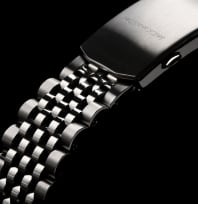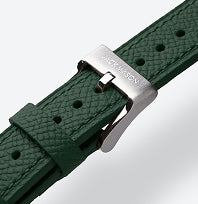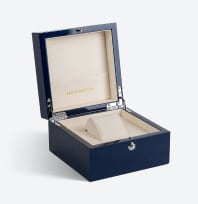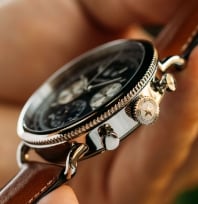The term waterproof is absolutely misleading.
The term waterproof actually implies that the watch will not leak under any circumstances. We will tell you right now that a totally waterproof watch is practically impossible. Therefore you should never fully trust the term waterproof when mentioned on the packaging or stamped directly on the back of the case.
”Waterproof”
So if the term waterproof isn’t enough, how can you know how “waterproof” your watch actually is? This is where water-resistant testing and ratings come into play. While no watch is actually 100% different waterproof ratings, usually noted on the back of the watch or the packaging the manufacturer includes with purchase, will assist you in knowing what kind of watch to choose for your specific needs.
Are Waterproof Watches Actually Waterproof?
How can you know what has the most waterproofing? What should you look for in water-resistance to understand what your watch can do? There are a few different rating systems that will help you know what your watch can withstand under the waves.
- BARs or ATM/Meters
- ISO - International Organization of Standards
- IP Code or IP Rating
The watch back is stamped with a water-resistance mark that denotes how much water pressure a watch can handle. The tested pressure is stated commonly in depth and meters of in BARs and ATM or atmosphere. The watch is labeled with a water resistance rating of 30, 50, 100, or even 200 meters, or 200m. There is an added level of standardization created and organized by the ISO or the International Organization of Standards. These two types are the most important to diving watch standards ISO ratings: ISO 2281 and ISO 6425.
BARS or ATM/Meters
A watch labeled at 30 meters would seem to mean that your watch is waterproof up to 30 meters. In reality, this rating is barely waterproof enough to handle standard handwashing or the occasional rain shower. It is not resistant enough to handle swimming, diving, or even showering and bathing. So what do these markings actually tell you about the watch’s waterproofing capabilities?
- 30m - Water resistant up to 30 meters - This means that your watch can withstand water droplets and quick handwashing.
- 50m - Water resistant up to 50 meters - Means it can withstand swimming and cold showers. Hot showers are a different subject as heat expands materials and could potentially allow water to enter your watch casing.
- 100m - Water resistant up to 100 meters - This means it is safe to swim or snorkel with the watch on, but it is not the right fit for diving.
- 200m - Water resistant up to 200 meters - Means you can dive with your watch on.
It is important to note that the waterproofing will become less effective over time as the seals are exposed to the elements and temperature changes.
The stamp on the back of the watch determines how far you can push your watch with water. Researching the watch style, the company, and their usage of the International Organization of Standardization will help uncover just how deep and under what kind of conditions your watch can withstand moisture and how “waterproof” it actually is.
Keep in mind that not all watch companies use these ratings. If using your watch in water is a significant concern, you will want to purchase a watch from the company of your choice with the highest meter rating to have the peace of mind that your watch will last through almost any condition you expose it to.
ISO Standards
ISO is the International Organization of Standardization. The ISO has different test ratings for water resistance conducted on watch faces and other electronic and mechanical components.
There are two primary standards of ISO to consider when purchasing a watch with some level of waterproofing:
- ISO 2281 Water Resistance Standard - All watches that are not diving watches.
- ISO 6425 Divers Watch Standard - Standards specifically for diving watches.
ISO 2281 Water Resistance Standard Test
This standardized test actually prohibits the term waterproof to be used when measuring the water-resistance of watches. If a watch states it is waterproof, this is a tale-tale sign that further research is needed to determine its water resistance. There is a limit to how much water pressure a watch face can stand. Waterproof implies that a watch will not leak under any circumstances, which is almost impossible.
The ISO 2281 test was invented in 1990 and updated in 2010 and is designed for watches created for regular, everyday use, not diving. The essential criteria for these tests cover:
- Water resistance
- Reaction to Temperature
- Reaction to Condensation
- Reaction to Pressure
This testing is relatively straightforward compared to the rigorous testing for Diver ISO testing and “water proofing”.
Diver ISO 6425 Testing
Diver ISO 6425 is the most rigorous set of waterproof testing on the market. Investing in an ISO compliant watch means you can be sure your watch will perform as advertised and will withstand the environmental factors you place upon it. After being ISO 6425 tested, the watch will have a rating for each specific feature, and it will meet specific criteria for diving and deep depths and pressure. In practical terms, it means that before you take your new 300m watch head into the water on your wrist, it’s already been 375 meters and back with loss in waterproofing.
A watch must pass several tests to receive an ISO 6425 rating, including tests that have nothing to do with water. However, these are the factors tested individually for “waterproof” watches:
- Reliability Under Water
- Resistance to Salt Water
- Reaction to Extreme Water Temperature Changes
- Reaction to Condensation
IP Code
The IP Code and rating system are governed by the International Electrotechnical Commission. While the IP Code may seem a wee bit more complicated, it is by far the most trusted, in large part because the IEC is so well-established. Similarly to BARs and meters, and ISO, the IP Code is based on a series of tests assigned a rating.
IP code rates the degree of protection provided by casings and electrical enclosures against intrusion or ingress of dust, accidental contact, and water.
This rating is written with the letters I and P, then two digits, followed by two more rating digits. The first two digits have to do with solids. So in the case of most watches, there is simply an IP followed by an X as the first digit is not as relevant to our watch decisions as waterproofing is.
Keep in mind that companies don’t have to rate their product for all IP Codes. Just because a watch has been tested and approved for IP 6 - powerful water jets, it doesn’t necessarily mean it was tested for the previous IPX codes. The numbers following the X will tell you exactly which types of moisture/water it has been tested to withstand.
If multiple tests have been performed, you will see them listed as IPX1/IPX3/IPX7. Looking for these multiple codes is going to be the only way to precisely know how waterproof, the moisture level, and the pressure your watch can handle.
The IP code measures waterproofing in bars and pressure, their rating system works as follows:
- X: No protection.
- Includes protection against vertically falling droplets, such as condensation. Ensures no damage or interrupted functioning of components will be incurred when water is falling onto the upright case.
- Protection against water drops from up to 15° when the case is upright.
- Protected against a water spray of up to 60° when the case is upright.
- Protected against water splashes from all directions. The case has been tested for at least 10 minutes with an oscillating spray.
- Includes protection against low-pressure jets of water directed from any angle, limited ingress permitted with no harmful effects.
- Protection against direct high-pressure jets.
- Protection against full immersion up to 30 minutes at depths between 15 cm and 1 meter, limited ingress permitted with no harmful effects.
- Protection against extended immersion under higher pressure, such as greater depths. This test’s precise parameters may include factors such as temperature fluctuations and flow rates, depending on equipment type, usually set by the manufacturer.
- 9K: Protection against high-pressure, high-temperature jet sprays, wash-downs, or steam-cleaning procedures.
What’s the best rating system? That really depends on your needs as a watch user and buyer. If you simply want to know if you can go swimming in your 30m watch, you now know the answer is no and that the ratings for the watches you can go swimming start at 100m or that you need at least an IPX7 to go snorkeling with your family. What matters most is that you are informed and can, at a glance, know if a watch is waterproof enough for what you need.
Sources:
https://www.iso.org/obp/ui/#iso:std:iso:22810:ed-1:v1:en
https://www.hodinkee.com/articles/tale-of-two-isos-what-water-resistance-ratings-really-mean












